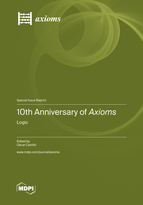10th Anniversary of Axioms: Logic
A special issue of Axioms (ISSN 2075-1680). This special issue belongs to the section "Logic".
Deadline for manuscript submissions: closed (31 December 2022) | Viewed by 18165
Special Issue Editor
Interests: type-2 fuzzy logic; fuzzy control; neuro-fuzzy; genetic-fuzzy hybrid approaches
Special Issues, Collections and Topics in MDPI journals
Special Issue Information
Dear Colleagues,
This year, Axioms will celebrate ten years since its first publication in 2012. To mark this significant milestone and celebrate the journal’s achievements throughout the years, we are organizing a Special Issue entitled "10th Anniversary of Axioms - Logic” in the section "Logic" of Axioms.
Mathematical logic is a field of mathematics with a wide range of applications. This Special Issue will consider high-quality papers presenting original research in logic, mathematical logic and their applications, with a particular emphasis on algebraic logic, fuzzy logic, descriptive set theory, decision making, computability and recursion theory and algorithmic and combinatorial optimization.
This Special Issue will commemorate the collective efforts of those who have contributed to the success of the journal and the further advancement in mathematical logic in solving current challenges, as well as future innovation in this field. Experts in this field are encouraged to contribute papers to this Special Issue.
Prof. Dr. Oscar Castillo
Guest Editor
Manuscript Submission Information
Manuscripts should be submitted online at www.mdpi.com by registering and logging in to this website. Once you are registered, click here to go to the submission form. Manuscripts can be submitted until the deadline. All submissions that pass pre-check are peer-reviewed. Accepted papers will be published continuously in the journal (as soon as accepted) and will be listed together on the special issue website. Research articles, review articles as well as short communications are invited. For planned papers, a title and short abstract (about 100 words) can be sent to the Editorial Office for announcement on this website.
Submitted manuscripts should not have been published previously, nor be under consideration for publication elsewhere (except conference proceedings papers). All manuscripts are thoroughly refereed through a single-blind peer-review process. A guide for authors and other relevant information for submission of manuscripts is available on the Instructions for Authors page. Axioms is an international peer-reviewed open access monthly journal published by MDPI.
Please visit the Instructions for Authors page before submitting a manuscript. The Article Processing Charge (APC) for publication in this open access journal is 2400 CHF (Swiss Francs). Submitted papers should be well formatted and use good English. Authors may use MDPI's English editing service prior to publication or during author revisions.
Keywords
- fuzzy logic
- type 2 fuzzy logic
- higher types of fuzzy logic
- intuitionistic fuzzy logic
- other forms of logic applications





